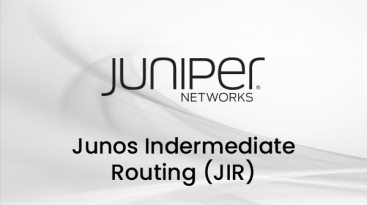Genel Bakış
This course provides students with intermediate routing knowledge and configuration examples. The course includes an overview of protocol-independent routing features, load balancing and filter-based forwarding, OSPF, BGP, IP tunneling and high availability (HA) features.
Eğitim Süresi 2 gündür.
Eğitim takvimi sayfamızda güncel eğitim tarihlerimizi bulabilirsiniz.
Eğitim Ön Koşulları
Students should have basic networking knowledge and an understanding of the Open Systems Interconnection (OSI) reference model and the TCP/IP protocol suite. Students should also attend the Introduction to the Junos Operating System (IJOS course prior to attending this class)
Eğitim İçeriği
Course Introduction
Protocol-Independent Routing
- Static Routes
- Aggregated Routes
- Generated Routes
- Martian Addresses
- Routing Instances
Load Balancing and Filter-Based Forwarding
- Overview of Load Balancing
- Configuring and Monitoring Load Balancing
- Overview of Filter-Based Forwarding
- Configuring and Monitoring Filter-Based Forwarding
Open Shortest Path First
- Overview of OSPF
- Adjacency Formation and the Designated Router Election
- OSPF Scalability
- Configuring and Monitoring OSPF
- Basic OSPF Troubleshooting
Border Gateway Protocol
- Overview of BGP
- BGP Attributes
- IBGP Versus EBGP
- Configuring and Monitoring BGP
IP Tunneling
- Overview of IP Tunneling
- GRE and IP-IP Tunnels
- Implementing GRE and IP-IP Tunnels
High Availability
- Overview of High Availability Networks
- Graceful Restart
- Graceful RE Switchover
- Nonstop Active Routing
- BFD
- VRRP
Eğitim Hedefleri
- Describe typical uses of static, aggregate, and generated routes.
- Configure and monitor static, aggregate, and generated routes.
- Explain the purpose of Martian routes and add new entries to the default list.
- Describe typical uses of routing instances.
- Configure and share routes between routing instances.
- Describe load-balancing concepts and operations.
- Implement and monitor Layer 3 load balancing.
- Illustrate benefits of filter-based forwarding.
- Configure and monitor filter-based forwarding.
- Explain the operations of OSPF.
- Describe the role of the designated router.
- List and describe OSPF area types.
- Configure, monitor, and troubleshoot OSPF.
- Describe BGP and its basic operations.
- Name and describe common BGP attributes.
- List the steps in the BGP route selection algorithm.
- Describe BGP peering options and the default route advertisement rules.
- Configure and monitor BGP.
- Describe IP tunneling concepts and applications.
- Explain the basic operations of generic routing encapsulation (GRE) and IP over IP (IP-IP) tunnels.
- Configure and monitor GRE and IP-IP tunnels.
- Describe various high availability features supported by the Junos OS.
- Configure and monitor some of the highlighted high availability features
Eğitime Kimler Katılmalı?
This course benefits individuals responsible for configuring and monitoring devices running the Junos OS.
- Genel Bakış
- Ön Koşullar
- İçerik
- Hedef
- Kimler Katılmalı?
Genel Bakış
This course provides students with intermediate routing knowledge and configuration examples. The course includes an overview of protocol-independent routing features, load balancing and filter-based forwarding, OSPF, BGP, IP tunneling and high availability (HA) features.
Eğitim Süresi 2 gündür.
Eğitim takvimi sayfamızda güncel eğitim tarihlerimizi bulabilirsiniz.
Eğitim Ön Koşulları
Students should have basic networking knowledge and an understanding of the Open Systems Interconnection (OSI) reference model and the TCP/IP protocol suite. Students should also attend the Introduction to the Junos Operating System (IJOS course prior to attending this class)
Eğitim İçeriği
Course Introduction
Protocol-Independent Routing
- Static Routes
- Aggregated Routes
- Generated Routes
- Martian Addresses
- Routing Instances
Load Balancing and Filter-Based Forwarding
- Overview of Load Balancing
- Configuring and Monitoring Load Balancing
- Overview of Filter-Based Forwarding
- Configuring and Monitoring Filter-Based Forwarding
Open Shortest Path First
- Overview of OSPF
- Adjacency Formation and the Designated Router Election
- OSPF Scalability
- Configuring and Monitoring OSPF
- Basic OSPF Troubleshooting
Border Gateway Protocol
- Overview of BGP
- BGP Attributes
- IBGP Versus EBGP
- Configuring and Monitoring BGP
IP Tunneling
- Overview of IP Tunneling
- GRE and IP-IP Tunnels
- Implementing GRE and IP-IP Tunnels
High Availability
- Overview of High Availability Networks
- Graceful Restart
- Graceful RE Switchover
- Nonstop Active Routing
- BFD
- VRRP
Eğitim Hedefleri
- Describe typical uses of static, aggregate, and generated routes.
- Configure and monitor static, aggregate, and generated routes.
- Explain the purpose of Martian routes and add new entries to the default list.
- Describe typical uses of routing instances.
- Configure and share routes between routing instances.
- Describe load-balancing concepts and operations.
- Implement and monitor Layer 3 load balancing.
- Illustrate benefits of filter-based forwarding.
- Configure and monitor filter-based forwarding.
- Explain the operations of OSPF.
- Describe the role of the designated router.
- List and describe OSPF area types.
- Configure, monitor, and troubleshoot OSPF.
- Describe BGP and its basic operations.
- Name and describe common BGP attributes.
- List the steps in the BGP route selection algorithm.
- Describe BGP peering options and the default route advertisement rules.
- Configure and monitor BGP.
- Describe IP tunneling concepts and applications.
- Explain the basic operations of generic routing encapsulation (GRE) and IP over IP (IP-IP) tunnels.
- Configure and monitor GRE and IP-IP tunnels.
- Describe various high availability features supported by the Junos OS.
- Configure and monitor some of the highlighted high availability features
Eğitime Kimler Katılmalı?
This course benefits individuals responsible for configuring and monitoring devices running the Junos OS.






